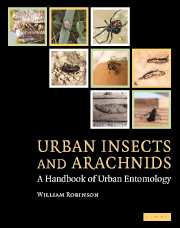Book contents
- Frontmatter
- Contents
- Preface
- Part I Urban entomology
- Part II Insects in the urban environment
- 4 Blattaria
- 5 Coleoptera
- 6 Collembola, Dermaptera
- 7 Diptera, Ephemeroptera
- 8 Hemiptera, Homoptera
- 9 Hymenoptera
- 10 Isoptera
- 11 Lepidoptera
- 12 Mantodea, Neuroptera
- 13 Orthoptera, Phasmatodea
- 14 Phthiraptera
- 15 Plecoptera, Psocoptera
- 16 Siphonaptera
- 17 Thysanoptera, Thysanura, Trichoptera
- Part III Other arthropods in the urban environment
- Family, genus, species index
- Index
- References
- Frontmatter
- Contents
- Preface
- Part I Urban entomology
- Part II Insects in the urban environment
- 4 Blattaria
- 5 Coleoptera
- 6 Collembola, Dermaptera
- 7 Diptera, Ephemeroptera
- 8 Hemiptera, Homoptera
- 9 Hymenoptera
- 10 Isoptera
- 11 Lepidoptera
- 12 Mantodea, Neuroptera
- 13 Orthoptera, Phasmatodea
- 14 Phthiraptera
- 15 Plecoptera, Psocoptera
- 16 Siphonaptera
- 17 Thysanoptera, Thysanura, Trichoptera
- Part III Other arthropods in the urban environment
- Family, genus, species index
- Index
- References
Summary
Introduction
Cockroaches are primarily tropical and subtropical insects, but they occur in nearly all of the climatic regions of the world. Most of the approximately 4000 described species live in small populations in forest habitats, some little-known species are semiaquatic, some are cave-dwelling, and a small number of species are associated with the nests of other insects. They are predominantly nocturnal and vegetarian, but many adjust their habits and food preferences to fit environmental conditions and available food resources. Cockroaches as a group are one of the most primitive winged insects, and seem to have remained in primitive habitats and undergone little morphological change since the Carboniferous geological period, about 250 million years ago. It is their association with decaying organic matter and humid conditions that maintains some species in the urban environment. Some have adapted to living indoors, but in this habitat they generally select sites that provide the temperature and humidity features of their natural habitat.
Adults are 10–50 mm long, brown to blackish brown or black, generally oval, and dorsoventrally flattened. Eyes are large and there are two ocelli, antennae are filiform and usually as long as or longer than the body. The head is usually concealed from above by a large pronotum, and chewing mouthparts are directed downwards. Legs have strong spines and setae, and the tarsi are five-segmented. Wings are present in most adults; the front wings are usually thickened and they overlap when closed over the abdomen.
- Type
- Chapter
- Information
- Urban Insects and ArachnidsA Handbook of Urban Entomology, pp. 35 - 64Publisher: Cambridge University PressPrint publication year: 2005
References
- 1
- Cited by



